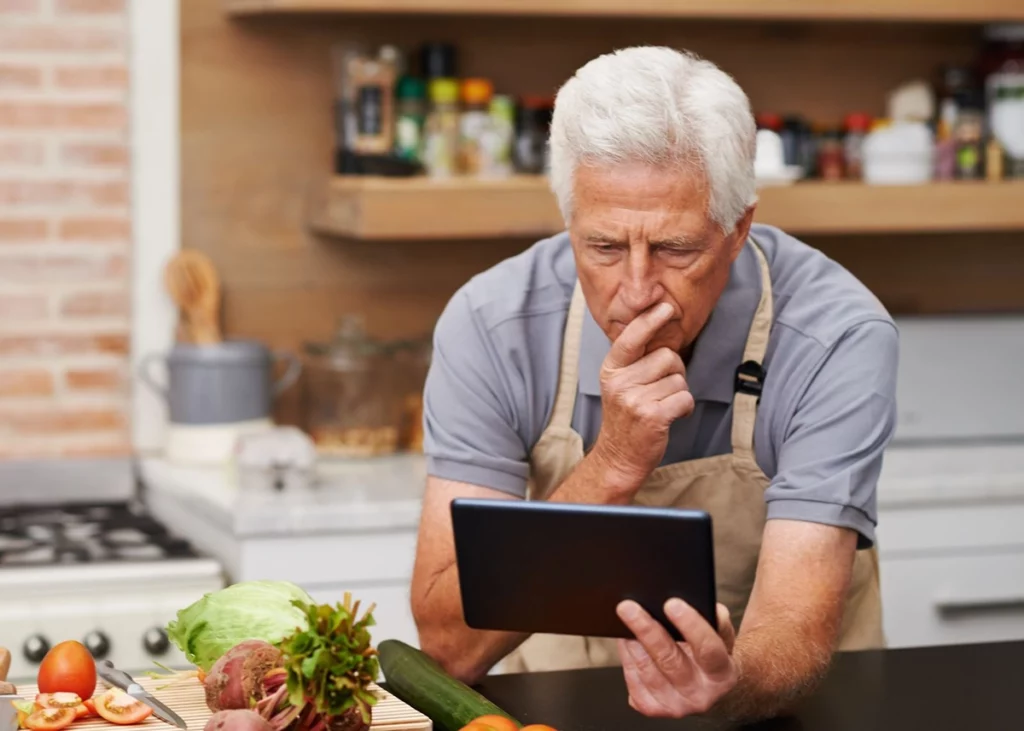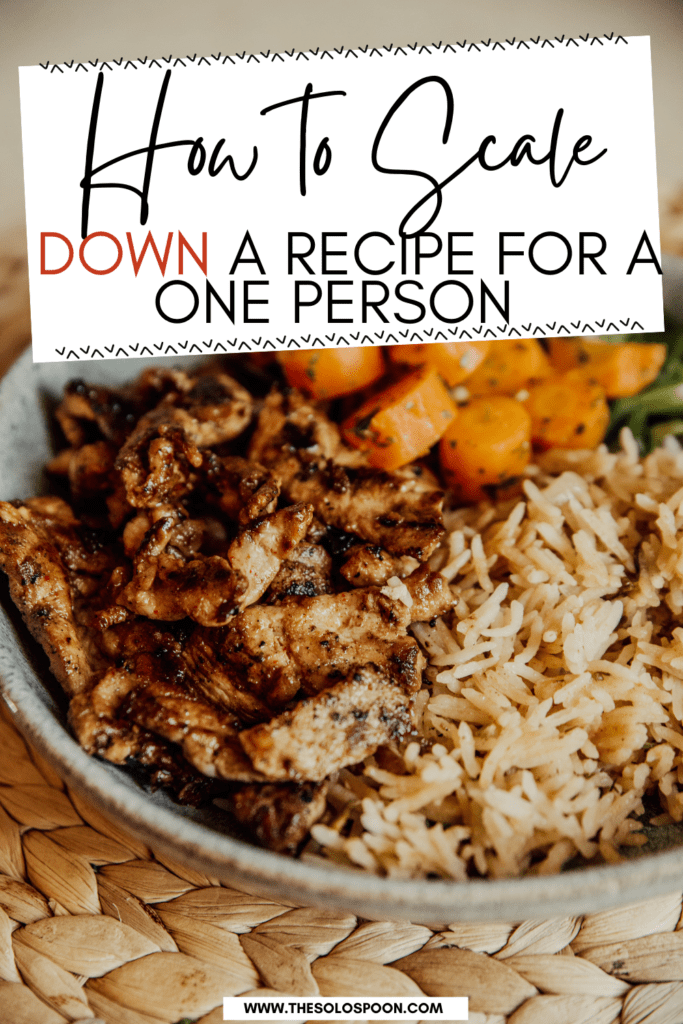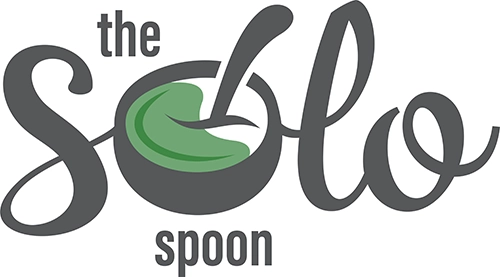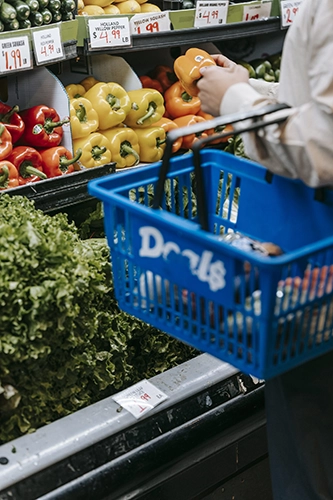How to Scale Down A Recipe for One Serving + PDF
Cooking for one – it’s a topic that often gets pushed to the back burner, isn’t it? There’s a pretty common myth out there that cooking for just one person is a hassle, feels like a chore, or is just plain lonely. But hold on – I’m here to spill the beans on why that’s simply not true! Cooking for one is a culinary adventure that’s all about you!
You’re the boss, the maestro in the kitchen who gets to decide what’s on the menu. Fancy some fusion cuisine? Or craving comfort food? It’s all up to you. Plus, it’s a chance to flex your creative muscles, experiment with ingredients, and whip up meals that are perfectly suited to your taste buds regardless of recipe size.
But let’s be honest, the road to solo cooking glory has its bumps. Most recipes you find are designed to feed a small army, leaving you scratching your head and wrestling with your third-grade math skills. And even when you nail the numbers, you end up with leftovers that last for days and half-used ingredients lounging in your fridge (we’ve all been there!).

Scaling Recipes When Cooking for One
This is where the magic of scaling down recipes comes to the rescue. Not only does it save you from drowning in a sea of leftovers, but it also helps avoid wasting precious ingredients. Plus, it’s a breeze to keep tabs on portion sizes when you’re cooking for yourself, helping you to maintain a balanced diet.
In today’s blog post, we’re going to master taking those family-sized recipes and tweaking them to perfectly cater to just one person. Whether you’re single, an empty-nester, or someone who just enjoys their own company, this guide is your ticket to creating fabulous meals for one and how to scale down a recipe.
The Basic Mathematics of Recipe Scaling
Now, let’s dive into the nitty-gritty of scaling down recipes. It’s not rocket science, I promise!
Who knew cooking could help dust off those old math skills, right? But don’t worry, the math here is pretty simple. Most recipes will have something called a recipe conversion factor. A recipe conversion factor is a number that is used to adjust the amount of each ingredient in a recipe. This is often necessary when you want to make the size of a recipe larger or smaller quantity of the final product than the recipe originally yields.
Example:
- Say, you’ve got a recipe that serves six, but you only need to feed yourself. All you’ve got to do is divide every ingredient quantity by six.
- And hey, if the recipe serves four, you divide by four. Easy as pie, right?
Just remember, when you’re scaling down, cooking times, baking time, and oven temperature instructions might need a bit of tweaking too, but we’ll get to that.
- For instance, if your recipe calls for 4 cups of flour and it serves 4 people, for just you, you’re only going to need 1 cup of flour.
- If it asks for 6 eggs and serves three, you’ll need 2 eggs just for you.
The first thing you can do when scaling a recipe is to calculate the number of portions you want for yourself. Although we are cooking for one there are different ways to calculate a serving size! Serving sizes can be a very personal matter and all single serve meals can come in different sizes based on your own hunger and determining the right amount of food for you.

Maintaining the Ratio of Ingredient Amounts
Here’s where the culinary magic happens! When we’re cooking or baking, ingredients are like a group of friends at a party. Everyone’s got a role to play, and it’s all about balance. So when scaling recipes, keep the proportions the same to ensure all flavors are partying in harmony.
Let’s say a cake recipe calls for 1 cup of flour and 1/2 cup of milk – that’s like a 2:1 party ratio between flour and milk.
When you’re cooking for one, you’ll want to maintain that same ratio to keep the party going, just on a smaller scale. If you’re making a half batch, you’ll use 1/2 cup of flour and 1/4 cup of milk. Make sense?
Common Measurements and Their Reduced Equivalents
Getting to know your teaspoons, tablespoons, and cups is a game-changer when scaling down recipes. And it’s actually kind of fun, like learning a new language, but with less grammar and more delicious food! Here are a few handy equivalents:
- 1 cup? That’s 16 tablespoons or 48 teaspoons.
- Half a cup? That’s the same as 8 tablespoons or 24 teaspoons.
- Want to halve that? A quarter cup equals 4 tablespoons or 12 teaspoons.
- Need something smaller? 1/8 of a cup is 2 tablespoons or 6 teaspoons.
- How about teaspoons to cups? 16 teaspoons make 1/3 of a cup.
- And let’s not forget the tablespoon:
- 2 tablespoons make up 1/8 of a cup.
- 1 tablespoon is the same as 3 teaspoons.
- 1/4 cup is 4 tablespoons.
- 1/3 cup is roughly 5 tablespoons and 1 teaspoon.
In addition to these basic measurements, it can be helpful to understand some standard cooking conversions:
- One medium-sized onion or bell pepper usually equates to about 1 cup when chopped.
- A clove of garlic will yield about 1 teaspoon of minced garlic.
- One medium-sized apple or banana will yield about 1 cup when chopped or mashed.
- One pound of uncooked pasta typically yields about 4 cups cooked.
Understanding these conversions will make it even easier to adjust your recipes to the serving size you need, whether you’re cooking for one or hosting a small gathering. Remember, cooking is as much an art as it is a science, so don’t be afraid to experiment a bit to find the perfect balance!
Master these basics and you’re well on your way to becoming a pro at scaling down recipes and cooking for one. Remember, it’s not just about eating; it’s about enjoying the process and the meal you’ve made just for you.
The above links are affiliate links. As an Amazon Associate, we earn from qualifying purchases at no additional cost to our readers.
Tips for Scaling Down A Full Recipe
Alright, now that we’ve gotten the basics down, let’s put on our aprons and dive into some handy tips that’ll make your solo cooking journey even smoother.
If you’re just starting cooking and scaling down recipes, to make it easier stick with simpler recipes. You know, the ones that don’t require you to use every pot and pan in your kitchen. This way, you can get the hang of reducing ingredients and adjusting cooking times without juggling too many elements at once. Plus, there’s something incredibly satisfying about whipping up a quick, delicious meal all for yourself.
Pay Attention to Cooking Times and Temperatures
When you’re scaling down recipes, remember that your cooking times might need a bit of a tweak. Smaller quantities of food often cook faster. So keep a close eye on your dish to avoid any unexpected charred surprises. The same goes for oven temperatures; sometimes, you might need to reduce the heat a smidge to avoid overcooking your scaled-down dish but the cooking time might be the same as the larger recipe.
Handling Difficult to Divide Ingredients (Like Eggs)
Okay, let’s address the egg in the room. Some ingredients are a bit trickier to scale down, like eggs. You can’t exactly chop an egg in half, right? In these cases, you might have to get a little creative. For example, you could whisk an egg, measure the total weight (we love our food scale!), and then use half of the mixture.
Or, if a recipe calls for one egg and you’re halving it, use a yolk or a white, depending on the recipe. Some recipes with eggs might even work if you whisk the egg and then measure out a certain amount of tablespoons for your recipe. The good thing is that you have options!
Consider Buying Smaller or Individually Packaged Ingredients
Sometimes, it might make sense to opt for smaller or individually packaged ingredients, especially if you’re finding half-used ingredients going bad in the fridge. Single-serve yogurt packs, apple sauce, mini cheeses, and half-sized loaves of bread can all make your life easier and help you cut down on food waste.
Use a Kitchen Scale for More Accurate Measurements
If you’re serious about your solo cooking adventure, a kitchen scale could be your new best friend. They’re perfect for nailing those tricky half (or third) measurements and ensuring your dish turns out just right every time.
We like having a food scale in our kitchen because it means we don’t have to dirty measuring cups and spoons when we can measure something very quickly by weight.
The above links are affiliate links. As an Amazon Associate, we earn from qualifying purchases at no additional cost to our readers.
Adjusting Spices and Seasonings
Just like any great adventure, scaling down recipes can come with a few challenges. But don’t sweat it! We’ve got some quick fixes for the most common pitfalls.
Scaling down spices and seasonings isn’t always as simple as it seems. Sometimes, halving the garlic might leave your dish lacking that flavorful punch, while cutting down chili could mean the difference between a pleasantly spicy dish and a mild one.
So, my advice? Trust your taste buds! Start with less and adjust as you go until you hit your flavor sweet spot. When you are scaling a recipe cooking for yourself you likely do not need to measure your seasonings. I like to season with my eyes and adjust as I cook.
Scaling Down Baking Recipes
Baking is a bit like chemistry, right? It’s all about the perfect balance, especially when it comes to leavening agents like baking powder and yeast. If these aren’t adjusted properly in a scaled-down recipe, you could end up with a flat cake or a loaf of bread that’s denser than a black hole.
So, make sure to adjust these ingredients carefully. If you’re unsure, there are plenty of conversion charts available online that can help. We also have a free cheat sheet in this blog post you can use to scale your favorite recipes.
Dealing with Recipes Requiring Special Equipment
Got a recipe that calls for a mammoth-sized stand mixer or a gargantuan baking dish, but you’re just cooking for one? Don’t worry, we’ve all been there. For most scaled-down recipes, smaller bowls and hand mixers work just fine.
As for baking dishes, try using a loaf pan, a smaller square pan, or even a half muffin tin for smaller portions. And remember, smaller portions might need less cooking time, so keep an eye on your dish as a general rule.
The above links are affiliate links. As an Amazon Associate, we earn from qualifying purchases at no additional cost to our readers.
Changes in Texture and Taste When Scaling Down
Sometimes, when you scale down a recipe, you might notice slight changes in texture and taste. This could be due to a number of factors, like changes in cooking time or ingredient proportions.
But hey, don’t let this deter you. Cooking for one is about experimenting and discovering what works for you. So, embrace the journey and remember – the best judge of a dish is your own palate!
Standard Recipe Demonstration
Okay, enough theory. Let’s get cooking! There’s nothing like a hands-on example to really drive home the art of recipe scaling. So, let’s take a classic crowd-pleaser, crepes, and scale it down from a brunch recipe for a whole family to a perfect breakfast for one.
Crepe Recipe Example
Crepes are delicious, versatile, and surprisingly simple, once you get the hang of them. Typically, a crepes recipe will serve around 14-15 people, but here’s how we can tweak it for just one person.
Original Recipe Ingredients for a Family Sized Crepe Recipe:
Simple Crepes
Yield: 14-15 crepes
Prep Time: 10 minutes Cook Time: 15 minutes Idle Time: 30 minutes
Ingredient Quantities:
Optional Toppings:
Specific Challenges in This Recipe
The next step, when scaling down this recipe is to take note of the egg amount and the cooking time. To scale down this recipe you’d start with the recipe yield and break this recipe in half and then into half again.
Using simple math that gives us about 3.75 so we will aim for about 3 crepes in our serving size for our scaled recipe. You can scale the recipe a third time if you want a smaller portion or until you get to your desired number of servings.
For the egg, we’re lucky in that a whole egg works perfectly for a single serving. However, if you were to scale this down further, you’d need to consider using either just the yolk or just the white.
This would be the ingredient breakdown for a crepe recipe for one person from our original number of servings:
Amount of Ingredients:
- 1 egg
- 1/2 teaspoon of white granulated sugar
- 1/2 tablespoon of unsalted butter, melted
- 1/4 cup + 2 tablespoons of milk
- 3 tablespoons of all-purpose flour
- A dash of vanilla extract
Cooking time is also a key factor. Your single serving crepes will likely need less time to cook than if you were making a large batch, so keep a close eye to avoid burning to make sure you hit that golden brown color we are going for. Working in small batches when cooking also allows you to get the best results without having to stand over the stove for a long period of time.
And remember – the best part about cooking for one is that you can fill your crepe with whatever you like, no compromises. Sweet or savory, it’s totally up to you.
Remember, practice makes perfect. If your first scaled-down recipe doesn’t turn out exactly as expected, don’t get disheartened. You’re learning a new skill, and with each recipe, you’ll get better and better.
Recommended Kitchen Tools for Single Serve Cooking
Now that you’re armed with all the tips and tricks for cooking for one, let’s talk about some extra resources that can take your solo culinary journey from satisfying to absolutely sensational.
To make your cooking adventures even smoother, here are some of our favorite kitchen tools that are perfect for single serve cooking:
- Mini Food Processor: Great for chopping small amounts of veggies or making single-serve sauces.
- Small Nonstick Skillet: Perfect for whipping up single serve meals like omelets or pancakes.
- Single Serve Blender: Ideal for making individual smoothies or protein shakes.
- Small Baking Dish: Perfect for a solo-sized lasagna or a sweet treat. Remember, you don’t need a ton of gadgets to make great meals for one. These are just some tools that can make the process a bit easier.
The above links are affiliate links. As an Amazon Associate, we earn from qualifying purchases at no additional cost to our readers.
Recommended Books And Blogs
Looking for more inspiration? Check out these fantastic resources that put the spotlight on cooking for one:
Cooking for One Cookbooks
- “Cooking Solo” by Klancy Miller: This cookbook offers a variety of delicious and exciting recipes designed for one person.
- Joe Yonan’s “Serve Yourself: Nightly Adventures in Cooking for One“: It’s filled with creative and flavorful meals for the solo cook.
- “Solo: A Modern Cookbook for a Party of One” by Anita Lo: A celebration of cooking for one by Michelin-starred chef Anita Lo.
The above links are affiliate links. As an Amazon Associate, we earn from qualifying purchases at no additional cost to our readers.
Cooking for One Blogs
- The Solo Spoon: That’s the blog you are on now! At the Solo Spoon we feel that cooking for one shouldn’t mean leftovers every night. We are here as a cooking for one resource for solo home cooks.
- Nourish Nutrition: The Nourish Nutrition Blog is a resource where you can find easy, flavorful recipes designed for single servings. All recipes have suggestions to use up leftover ingredients, making it efficient and reducing waste. The goal of the blog is to make it worthwhile to cook for one.
- One Dish Kitchen: The One Dish Kitchen Blog aims to inspire individuals with access to single serving recipes. The goal is to enable readers to enjoy the preparation of a meal that will nourish both body and soul. The website is filled with hundreds of easy, flavorful recipes that are tailored for those cooking for one.
- Single Serving Size: The blog Single Serving Size is a Blog that provides recipes intended for one person. The author of the blog is someone who lives alone and loves to cook. They created the blog to share their passion for cooking and the dishes they love, all scaled down to single servings.
- Gourmet for One: The Blog Gourmet for One is focused on sharing fresh, healthy, and easy recipes that are specifically designed for one or two people. The blog’s creator is a bachelor who has spent a significant amount of time cooking for one or two people and has noticed a lack of available recipes catering to individuals or small households. The blog aims to fill this gap by combining the author’s passions for cooking and photography to provide enjoyable recipes for people cooking on their own.
- Single Serving Chef: The Single Serving Chef Blog was started by a blogger who was diagnosed with anemia and malnutrition. The blog was created as a means to focus on getting the necessary nutrients, and the blogger found that sharing recipes helped to keep them motivated.

Printable Recipe Scaling Cheat Sheet PDF For Download
To help you scale your recipes like a pro, we’ve created a handy recipe scaling cheat sheet. It’s perfect for quick reference when you’re in the middle of cooking. You can download and print it for easy access in your kitchen. Add your email below to get your free printable Recipe Scaling Cheat Sheet.
Now You Are A Pro On How to Scale Down Recipes
We’ve been on quite the culinary journey in this blog post, haven’t we? From mastering the math of recipe scaling, to navigating the common pitfalls, and even doing a live-demo with a classic crepe recipe, we’ve covered a lot of ground.
Whew! Now that you’re equipped with all this knowledge, it’s time for the real fun to begin. My challenge for you? Take a recipe you love, scale it down, and cook yourself a delicious meal. Remember, cooking for one and being able to scale down any recipe is an opportunity to experiment, an easy way to be creative, and treat yourself. So go ahead, take the plunge. Your kitchen is your new playground.
And hey, don’t forget to share your solo cooking adventures with us. We can’t wait to see what you whip up! Tag us at @thesolospoon in your next post to let us know what you are making. Happy cooking!
Our Favorite
Cooking for One Resources
Don’t forget to pin this for later!

Cooking for One & Scaling Resources
- The Solo Spoon
- Nourish Nutrition
- One Dish Kitchen
- Single Serving Size
- Gourmet for One
- Single Serving Chef
- Scale Down A Recipe Calculator
Great resources when you are looking for cooking for one recipes!





















